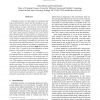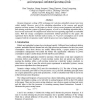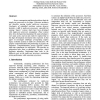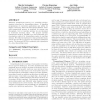IPPS
2007
IEEE
14 years 7 months ago
2007
IEEE
As real-time systems become more prevalent, there is a need to guarantee that these increasingly complex systems perform as designed. One technique involves a static analysis to p...
ECRTS
2007
IEEE
14 years 7 months ago
2007
IEEE
Feedback control techniques have recently been applied to a variety of real-time systems. However, a fundamental issue that was left out is guaranteeing system controllability and...
RTCSA
2008
IEEE
14 years 7 months ago
2008
IEEE
Real-time systems are often designed using preemptive scheduling to guarantee the execution of high priority tasks. For multiple reasons there is a great interest in exploring non...
RTAS
2008
IEEE
14 years 7 months ago
2008
IEEE
Embedded systems are often subject to constraints that require determinism to ensure that task deadlines are met. Such systems are referred to as real-time systems. Schedulability...
RTAS
2008
IEEE
14 years 7 months ago
2008
IEEE
In the domain of multiprocessor real-time systems, there has been a wealth of recent work on scheduling, but relatively little work on the equally-important topic of synchronizati...
ISORC
2008
IEEE
14 years 7 months ago
2008
IEEE
Reusable libraries are problematic for real-time software in Java. Using Java’s standard class library, for example, demands meticulous coding and testing to avoid response time...
FGCN
2008
IEEE
14 years 7 months ago
2008
IEEE
Dynamic frequency scaling (DFS) techniques for real-time embedded systems have been widely studied. However, most of the scheduling algorithms so far concern only special purpose ...
ETFA
2008
IEEE
14 years 7 months ago
2008
IEEE
Power consumption and thermal problems limit the single-core processors to be faster. Processor architects are therefore moving toward multi-core processors. Developers of embedde...
SAC
2010
ACM
14 years 7 months ago
2010
ACM
Hardware transactional memory is a promising synchronization technology for chip-multiprocessors. It simplifies programming of concurrent applications and allows for higher concu...
CASES
2009
ACM
14 years 7 months ago
2009
ACM
A common problem in event-triggered real-time systems is caused by low-priority tasks that are implemented as interrupt handlers interrupting and disturbing high-priority tasks th...




